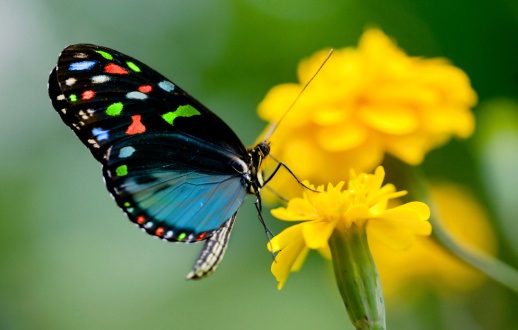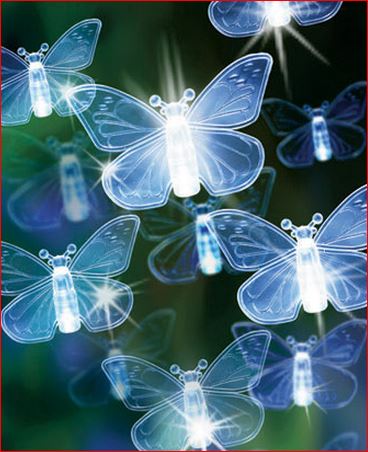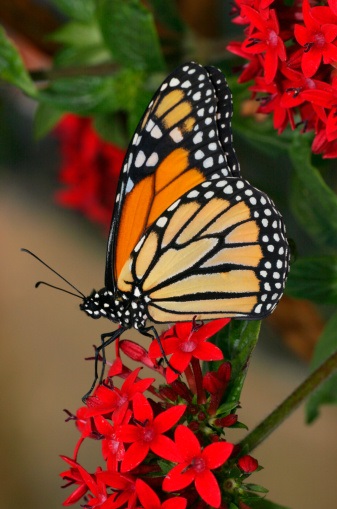Learn About Butterflies Day: Fun Facts About Butterflies
 The days are getting longer, the temperatures are rising and birds are singing the sweet songs of spring! Pretty soon we’ll start seeing butterflies fluttering around the trees and flowers and, since, March 14 is also dedicated as Learn About Butterflies Day, we dug up few fun facts about butterflies to get you excited about the season.
The days are getting longer, the temperatures are rising and birds are singing the sweet songs of spring! Pretty soon we’ll start seeing butterflies fluttering around the trees and flowers and, since, March 14 is also dedicated as Learn About Butterflies Day, we dug up few fun facts about butterflies to get you excited about the season.
Eating and Drinking According to the San Diego Zoo, there are a few ways butterflies get their nutrients. Before they transform from from caterpillar to butterfly, they eat leaves to survive. After they go through metamorphosis and change from a squirmy insect to a beautiful flying bug, they only sip on liquids — juice from fruit, nectar from flowers and sap from trees. Those things give butterflies most of what they need, but they don’t provide minerals, so male butterflies sip water from mud puddles — it’s called “puddling.” They share those nutrients they get from puddles with females during the mating process.
 After mating, when butterflies are ready to lay their eggs, they scope out leaves and plants by tasting them with their feet! If they find leaves tasty enough for their offspring, they’ll lay eggs on the leaves. When the eggs hatch, the caterpillars will eat the leaves on which they are born and the life cycle begins again.
After mating, when butterflies are ready to lay their eggs, they scope out leaves and plants by tasting them with their feet! If they find leaves tasty enough for their offspring, they’ll lay eggs on the leaves. When the eggs hatch, the caterpillars will eat the leaves on which they are born and the life cycle begins again.
Flying While we usually just see butterflies fluttering from flower to flower without urgency, they can fly quite fast. Most butterflies fly about 5 to 12 miles an hour, but some skipper butterflies can reach speeds of up to 35 miles an hour! Skippers are a little bit different from other butterflies — you can tell them by their antennae; they look like little crochet hooks.
But butterflies can’t fly all the time — they are ruled by the weather — which isn’t a surprise since we usually only see them during the spring and summer. Temperature is very important in their travels. They don’t take off if the air temperature is less than 55℉ and if their body temperature is less than 85℉.
 Lifespan Butterfly life span varies. The brimstone butterfly lives the longest with an average of 9 to 10 months, but some species live only a week or two. But that is over-simplifying the complicated lives of butterflies. There are many things to consider when calculating the lifespan of a butterfly: how long they’re in the larval (egg) and pupal (cocoon) stages, hibernation, and weather conditions. Butterflies and Moths of North America goes into detail about how long butterflies live.
Lifespan Butterfly life span varies. The brimstone butterfly lives the longest with an average of 9 to 10 months, but some species live only a week or two. But that is over-simplifying the complicated lives of butterflies. There are many things to consider when calculating the lifespan of a butterfly: how long they’re in the larval (egg) and pupal (cocoon) stages, hibernation, and weather conditions. Butterflies and Moths of North America goes into detail about how long butterflies live.
Defense There are many ways butterflies protect themselves from predators. As caterpillars, they either roll themselves up in leaves or burrow into fruit or wood to hide — some even make themselves look like twigs. As winged adults, they can hide the brightly colored side of their wings and show only the dull side to make them less visible. Some butterflies can even disguise themselves as dead leaves. The more beautiful butterflies — like the Monarch — don’t taste very good to predators — of course one has to die for a predator to learn its lesson, but the death of one beautiful butterfly means many more will survive.
We’re excited about all the life spring brings to our gardens! Butterflies, flowers and birds — we’re working on making homes for them in our yards and The Lakeside Collection has dozens of products and ideas to make your garden attractive for all your favorite critters.






